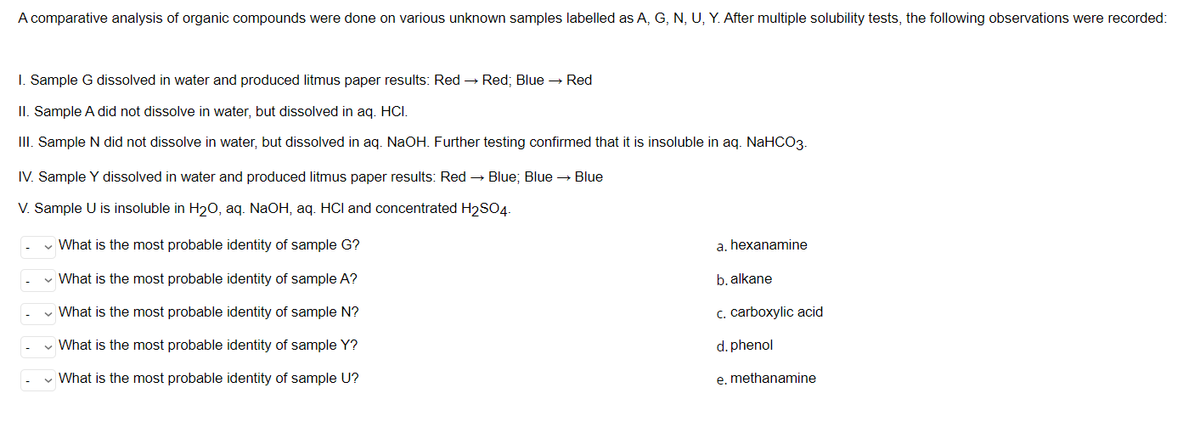A comparative analysis of organic compounds were done on various unknown samples labelled as A, G, N, U, Y. After multiple solubility tests, the following observations were recorded: I. Sample G dissolved in water and produced litmus paper results: Red - Red; Blue - Red II. Sample A did not dissolve in water, but dissolved in aq. HCI. III. Sample N did not dissolve in water, but dissolved in aq. NaOH. Further testing confirmed that it is insoluble in aq. NaHCO3. IV. Sample Y dissolved in water and produced litmus paper results: Red → Blue; Blue - Blue V. Sample U is insoluble in H20, aq. NaOH, aq. HCI and concentrated H2SO4. v What is the most probable identity of sample G? a. hexanamine - What is the most probable identity of sample A? b. alkane v What is the most probable identity of sample N? c. carboxylic acid v What is the most probable identity of sample Y? d. phenol v What is the most probable identity of sample U? e. methanamine
A comparative analysis of organic compounds were done on various unknown samples labelled as A, G, N, U, Y. After multiple solubility tests, the following observations were recorded: I. Sample G dissolved in water and produced litmus paper results: Red - Red; Blue - Red II. Sample A did not dissolve in water, but dissolved in aq. HCI. III. Sample N did not dissolve in water, but dissolved in aq. NaOH. Further testing confirmed that it is insoluble in aq. NaHCO3. IV. Sample Y dissolved in water and produced litmus paper results: Red → Blue; Blue - Blue V. Sample U is insoluble in H20, aq. NaOH, aq. HCI and concentrated H2SO4. v What is the most probable identity of sample G? a. hexanamine - What is the most probable identity of sample A? b. alkane v What is the most probable identity of sample N? c. carboxylic acid v What is the most probable identity of sample Y? d. phenol v What is the most probable identity of sample U? e. methanamine
Chemistry
10th Edition
ISBN:9781305957404
Author:Steven S. Zumdahl, Susan A. Zumdahl, Donald J. DeCoste
Publisher:Steven S. Zumdahl, Susan A. Zumdahl, Donald J. DeCoste
Chapter18: Electrochemistry
Section: Chapter Questions
Problem 9RQ: What characterizes an electrolytic cell? What is an ampere? When the current applied to an...
Related questions
Question

Transcribed Image Text:A comparative analysis of organic compounds were done on various unknown samples labelled as A, G, N, U, Y. After multiple solubility tests, the following observations were recorded:
I. Sample G dissolved in water and produced litmus paper results: Red → Red; Blue → Red
II. Sample A did not dissolve in water, but dissolved in aq. HCI.
III. Sample N did not dissolve in water, but dissolved in aq. NaOH. Further testing confirmed that it is insoluble in aq. NaHCO3.
IV. Sample Y dissolved in water and produced litmus paper results: Red → Blue; Blue → Blue
V. Sample U is insoluble in H2O, aq. NaOH, aq. HCl and concentrated H2SO4.
What is the most probable identity of sample G?
a. hexanamine
What is the most probable identity of sample A?
b. alkane
What is the most probable identity of sample N?
c. carboxylic acid
What is the most probable identity of sample Y?
d. phenol
What is the most probable identity of sample U?
e. methanamine
Expert Solution
This question has been solved!
Explore an expertly crafted, step-by-step solution for a thorough understanding of key concepts.
Step by step
Solved in 3 steps with 1 images

Knowledge Booster
Learn more about
Need a deep-dive on the concept behind this application? Look no further. Learn more about this topic, chemistry and related others by exploring similar questions and additional content below.Recommended textbooks for you

Chemistry
Chemistry
ISBN:
9781305957404
Author:
Steven S. Zumdahl, Susan A. Zumdahl, Donald J. DeCoste
Publisher:
Cengage Learning

Chemistry: An Atoms First Approach
Chemistry
ISBN:
9781305079243
Author:
Steven S. Zumdahl, Susan A. Zumdahl
Publisher:
Cengage Learning


Chemistry
Chemistry
ISBN:
9781305957404
Author:
Steven S. Zumdahl, Susan A. Zumdahl, Donald J. DeCoste
Publisher:
Cengage Learning

Chemistry: An Atoms First Approach
Chemistry
ISBN:
9781305079243
Author:
Steven S. Zumdahl, Susan A. Zumdahl
Publisher:
Cengage Learning


Principles of Modern Chemistry
Chemistry
ISBN:
9781305079113
Author:
David W. Oxtoby, H. Pat Gillis, Laurie J. Butler
Publisher:
Cengage Learning
